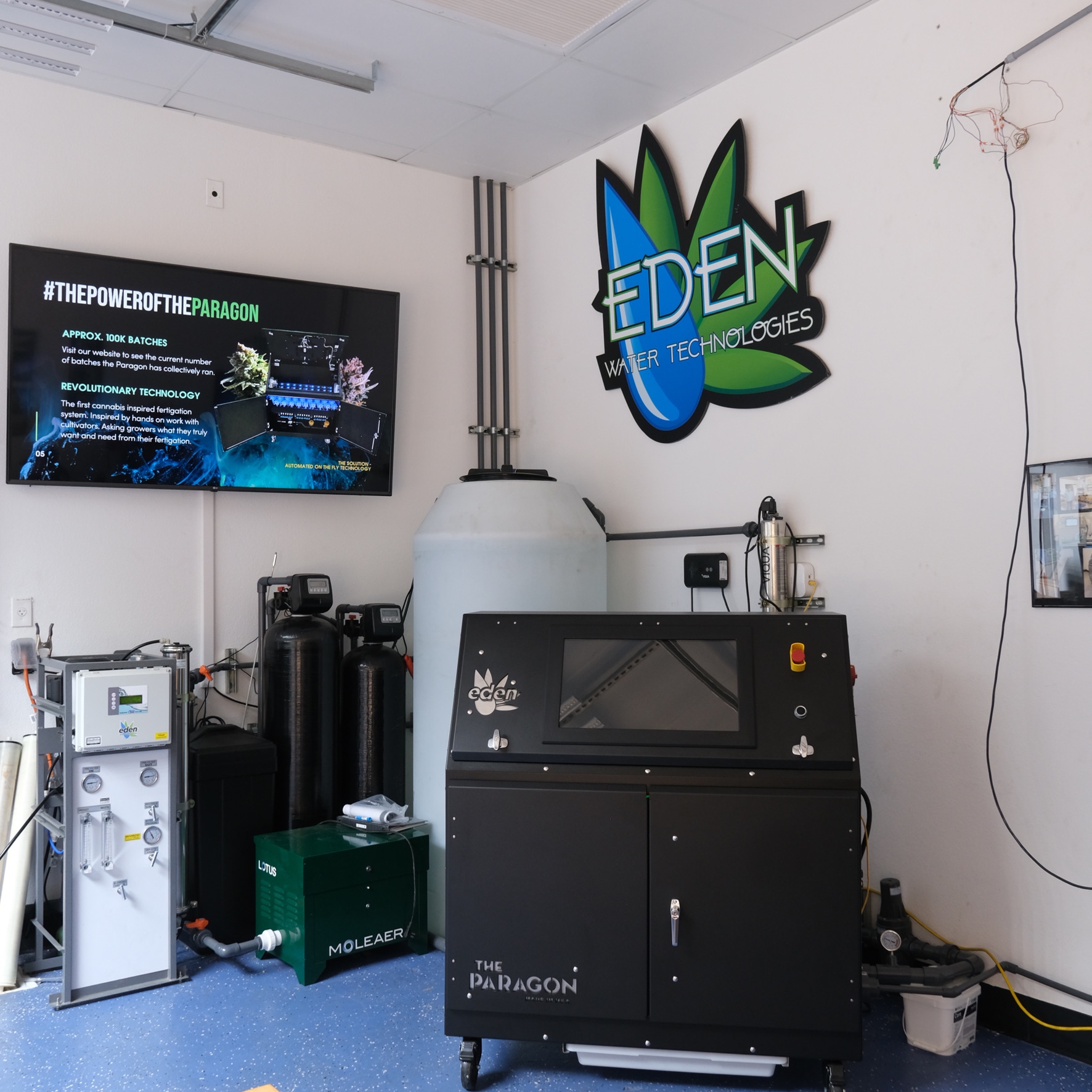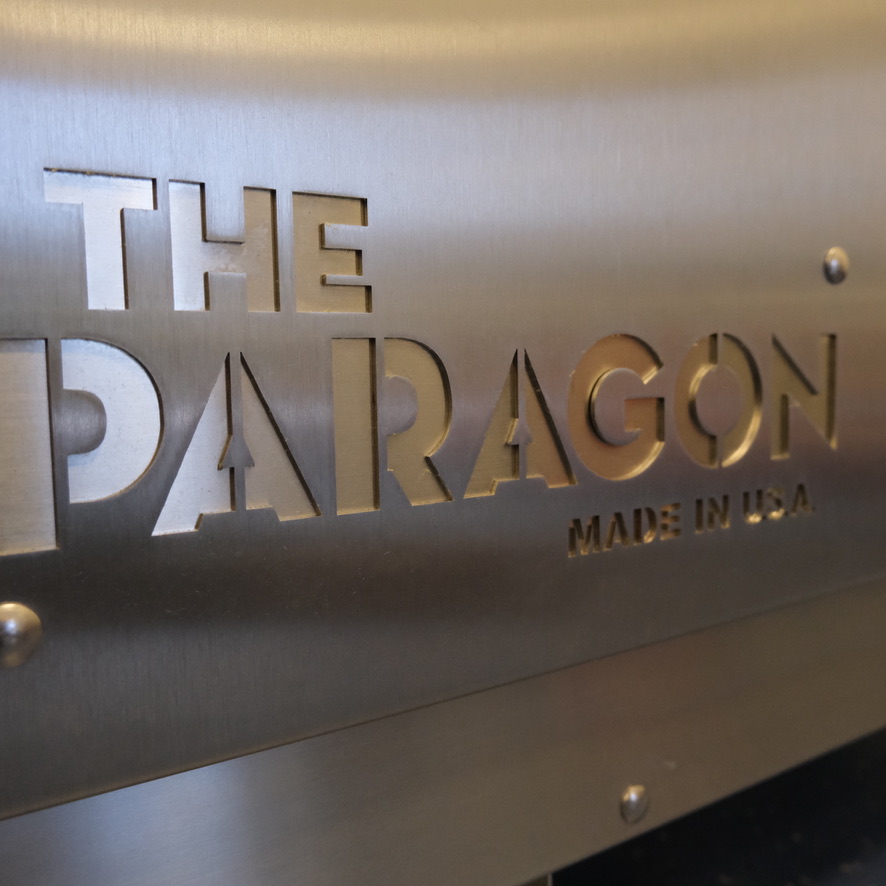

Eden Water Technologies - We’re Revolutionizing Water Treatment & Fertigation for Cannabis
We’re Revolutionizing Water Treatment & Fertigation for Cannabis

We’re Revolutionizing Water Treatment & Fertigation for Cannabis

Automated fertigation is complex. It includes intricate piping systems, irrigation, pumps, controls, sensors, and extensive nutrient delivery.
New technology and updated practices can be scary to those who are resistant to change. Learning the ins and outs of automated fertigation can take years of experience and research.
If you’re looking to learn more about automated fertigation, you’ve come to the right place! This blog will cover the basics of automated fertigation for the cannabis cultivator. It is laid out to be easy to understand and to turn the complicated process into easy-to-digest nuggets. Let’s get started!
The days of hand-mixing your recipes are gone. Automated fertigation allows cannabis cultivators to avoid some of the most painstaking and time absorbing tasks at your facility. Here’s a short list of issues that an advanced automated fertigation system can solve:
When you don’t have to hand mix recipes, measure your nutrients, and hand water your plants it gives your skilled cultivators time to nurture the plants and perform better plant maintenance – thus creating higher yields in your grow facility. New systems are freeing you from these problems, and we’re here to help you understand the latest in fertigation technology.
To state it simply, automated fertigation is the method of sending a precise amount of nutrients and water to your crop through piping and irrigation.
Effective irrigation and fertigation will ensure your cultivation will produce high-quality plants that produce higher yields. Automated fertigation allows cultivators to have peace of mind knowing their plants are being nourished the way they should be. Automating your dosing procedures can also cut production costs greatly. Cultivations will reduce their fertilizer cost, water usage, and also save on labor costs.
If a cultivation decides to scale up and automate, automated fertigation is an effective process to adopt because it offers a high rate of efficiency, accuracy, and consistency. Hand mixing nutrients is time-consuming and is vulnerable to costly human error. Automated fertigation systems are highly reliable, efficient, and never take a day off.
The two main forms of automated fertigation are batch injection and in-line or direct injection.
Batch injection uses a mixing tank to make the recipe as needed or multiple batch tanks that can only hold 1 recipe at a time. A full batch will typically be mixed before it is sent to the plants through your piping system. It’s important to keep in mind that the more recipes you have, the more tanks, pumps, and piping systems you will need.
With a majority of cultivations using 6-8 recipes, using these cumbersome batch tanks can really be daunting. The staff will need to do daily checks on these tanks. It is crucial to check the pH and EC often because chemical imbalances often occur. The longer the tanks sit, the harder it becomes to know the composition of each batch.
These tanks require frequent cleanings to avoid sediment build up. This build up can affect pH levels, possibly unbalancing the nutrients that are sent to your crop. Temperature changes and the introduction of light inside these tanks can also bring the risk of algae and bacteria forming. Algae will significantly reduce the dissolved oxygen in the tank, which is essential to nutrient absorption. It is recommended that they are cleaned after each batch to ensure to not disrupt the next recipe. New or disinfected cleaning equipment should be used to clean your tanks to avoid contamination. Be sure to also follow the OSHA guidelines regarding confined spaces.
In-line or direct injection fertigation uses dosers, or injection units to mix the nutrients to water ratio as needed, then this recipe is sent to your plants or to a holding tank. Drastically simplifying your feeding techniques. This method will positively impact water and nutrient usage as well as contribute to reducing disease in your crop. Direct injection systems can also reduce physical labor, letting your staff pay closer attention to the plants themselves. For many larger facilities, it is likely to eliminate the need of at least one to two full-time employees. This can save a facility over $100k a year. Although the initial cost for these systems can be high, their ROI (return on investment) happens very quickly and the benefits are endless.
Even if your fertigation system is highly automated, it is advised to continue to physically check lines on a daily basis. Be sure your irrigation is up to par by checking for clogged emitters and leaks. Leaking pipes and irrigation can throw off nutrient distribution and flow rates. Flushing your system routinely can help to keep a lot of these issues at bay. Also be sure to keep your nutrient tanks stocked so each recipe is complete every time. With direct injection fertigation, and minimal regular maintenance these systems can be extremely reliable and cost-effective.
With continued advancements in fertigation technology, there is now a way to send your recipes on-the-fly, or “on-demand” without the need for batch tanks. This gives cultivators the ability to have their recipes mix automatically and deliver them on-demand with a user-defined schedule or crop plan. There is no pre-mixing of nutrients and water. This process removes the need for any hand mixing, which significantly decreases any room for wasted time and resources while keeping processes consistent. This can also greatly reduce the risk of costly human error. Bringing in new cultivation staff will be less of a headache knowing that your on-demand fertigation system has already been set up and your recipes are dialed in.
Maximum Yield notes that, “there are about 20 essential nutrients needed for optimal cannabis growth and development.” We know that a few of these are found in the natural environment like oxygen, hydrogen, and carbon. Even excluding those three nutrients, you are left with 17+ macro, secondary and micronutrients to mix into the perfect recipe for your plants.
Many cultivators have trial and error phases before finding the right recipe for their crop, or experiment with adding in additional micronutrients as they grow. When using traditional methods of fertigation the process of experimenting with nutrients would likely include filling, mixing, and pumping recipes into large batch tanks, then having the tedious job of hand feeding the plants.
With advanced on-demand fertigation systems, you can offer thousands of recipe combinations to your crop. Formula masters and companies are dedicated to creating recipes that are perfectly formulated for your strains of cannabis. Luckily for you, on-demand fertigation can send those custom recipes to your plants throughout your facility with limited waste and precise measurements.
Nik McCalligan, President of Eden Water Technologies, comments on the impact of their on-demand fertigation machine, “The difference of The Paragon is that every other fertigation system unless customized, can only run six or eight nutrients. A typical line like Athena, Front Row AG, or General Hydro requires around six nutrients. So if you’re running a six-part Athena recipe, but you want to try a six-part Front Row, you have to flip your whole facility or hand mix for a subzone. The Paragon allows you to run multiple lines at the same time. You’re able to batch Front Row for zone one, and Athena for zone two, sequentially.”
Pretty impressive. If you’re interested in learning more about how The Paragon offers unlimited on-demand recipes, click here.
All of those nutrients and recipes are only as good as the piping system getting them to your plants. Choosing whether you will have an on-demand fertigation system or a batch tank system is the first step in determining how your pipes will work.
Traditional or batch tank piping systems are based on a “what if” strategy to ensure you have enough pressure to run ALL of your outlets. This thought process in a grow facility drastically increases the number and size of pipes and pumps you need to run your facility.
Daily Life Example: Your home has two hose bibs, two showers, four sinks, and three toilets. What if they all ran at once? Traditional piping systems are designed to accommodate full flow of all of those items at once. This same model is used when calculating for a grow facility using outdated fertigation methods.
Updated irrigation techniques that run in tandem with on-demand fertigation systems use a “what DO you need” instead of “what MIGHT you need” methodology. To figure out what you DO need Eden Water Technologies suggests pulling out a calculator to do some basic calculations to figure out how much flow you actually need to get water and nutrients to your plants. Here’s a breakdown of what to look out for with pumps provided by Nik McCaligan, President of Eden Water Technologies:
If you work backward in your cultivation process, starting with your emitter size, you can easily calculate your flow rate to determine the proper size and amount of piping you need. Here’s a guide to determining your proper pipe size:
It’s common to see 1 ½ – 2 inch pipes in a cultivation facility and you will quickly see by using the above guide that using these pipes is too large, even with doubling your flow needs. If you’re ready to switch to advanced on-demand fertigation you can find yourself getting properly fit for pipes, zone sizing, and reviewing water requirements.
With The Paragon on-demand fertigation system we do all the work for you. The internal pump is sized to work with the flow range that the system operates in. In the case that you are not yet a Paragon owner, you may need to size your pump yourself. Here are a few questions you should ask yourself:
There are a lot of pump options out there. Some may seem like an easy choice because you see popular industry professionals using them. However, it is still up to you to pick what your cultivation needs. Every cultivation is unique and should be treated as such.
Be sure to read the directions. Find out what that pump was designed for? Stay away from pumps that have strict liquid quality requirements. Also stay away from cast iron pumps, as they are porous which can produce bacteria, and if not coated it can cause leaching that will lead to corrosion.
Each pump manufacturer has documentation on something called the “pump curve”. As flow increases, pressure decreases. There are great pumps out there that are built to do 100+gpm (gallons per minute) at 25 psi (pounds per square inch). If your need is 5 gpm at 40 psi this probably isn’t the pump for you. When purchasing a pump, don’t go solely off of hydro store advice and social media. Do your homework and figure out exactly what your cultivation needs before you purchase a pump. Feel free to contact Eden Water Technologies and we will gladly help you through the process.
Our nutrient pumps are variable-speed peristaltic pumps that utilize a stepper motor. This means they can pump the precise amount of nutrients the recipe requires with the utmost accuracy. Each nutrient in your recipe will start pumping, and stop pumping at the same time. This ensures an even distribution through your crop. Most fertigation systems out there use pumps made from lower quality materials and can take an excessive amount of time to prime and calibrate. The Paragon’s nutrient pumps are stainless steel and feature high-quality components that are built to last. Calibrating these pumps is extremely simple and can be done in a short period of time.
No, we’re not talking about your favorite TV show, but we are talking about technology at the push of a button. Technology around the world has made our lives easier. We can set our coffee pot to go off automatically every morning, and Alexa can turn our lights on and off each night with an app. That automated technology is now accessible for your fertigation techniques.
Thanks to The Paragon you can schedule your feedings for the crops cycle, or input a new formula that is delivered instantly all with the push of a few buttons. The Paragon has a built in user interface that allows you to schedule your recipes to all of your zones around the facility on a schedule or crop plan. This allows you to individualize your techniques for each plant’s specific nutrient and water needs. Which keeps your feedings organized and organization means less work and worry.
Packed with 18 nutrient pumps you can push your needed recipes out to plants without the use of batch tanks. The advanced system accurately measures and injects your concentrated nutrients into your piping system, mixing with water and flushing your pipes at the same time.
The system also has countermeasures in place for quality assurance. If your recipe is not within the user-defined parameters, you will be notified immediately and the system will satisfy that by feeding with water to ensure your plants stay healthy.
Within the built-in user interface (or from your phone/laptop) you can check the levels left in your nutrient pumps, review past feeding schedules, and review historical recipes that worked well. Gone are the days of batch tanks. The system is also extremely user friendly. Your staff will be able to quickly adapt to the technology. If you’re looking for a more in-depth description of how the user interface works, contact the Eden Team.
The Paragon On-Demand Fertigation has made its way into the cannabis industry, and everyone is wondering, is this for me? The easy answer is, HELL YES. Such advanced fertigation is meant for facilities of all shapes and sizes – including yours. The Paragon is a revolutionary on-demand system that has the capability of adapting to most cannabis cultivations big and small.
When properly engineered, a commercial fertigation system is as good as your best employee and has an enviable return on investment. Nik McCalligan says, “I truly believe the Paragon is the most cost-effective way to ensure uniformity with irrigation. This is the foundation for large-scale success in all cultivations.”
It’s our goal at Eden to give growers information to want to learn more and ask the questions needed to upgrade their facility. If you’re ready to learn more about The Paragon, contact the Eden Water Technologies Team today.

Cannabis cultivation requires precision, reliability, and expertise—especially in challenging climates like the desert regions of Las Vegas and Phoenix. Eden Water Tech delivers industry-leading water

At Eden Water Tech, our mission is to provide the best solutions for your cannabis cultivation needs. We’re thrilled to announce a major milestone: the

Introduction:In the dynamic world of agriculture, innovation is the driving force behind progress. Meet the Paragon fertigation machine – a groundbreaking technology that emerged from

Introduction: In the ever-evolving world of ag-tech, Eden Water Tech is making waves with its innovative Paragon Fertigation System. Let’s dive into the strides taken

Join our email list for exclusive ebooks, tips, and the latest in cannabis fertigation and irrigation solutions.

We’re Revolutionizing Water Treatment & Fertigation for Cannabis
Designed by ThrivePOP ❤️